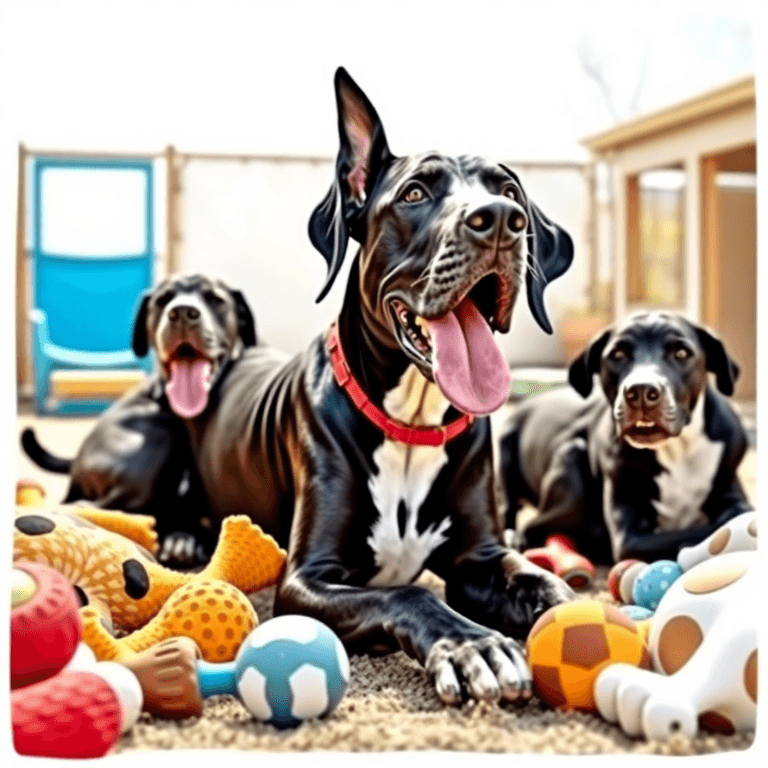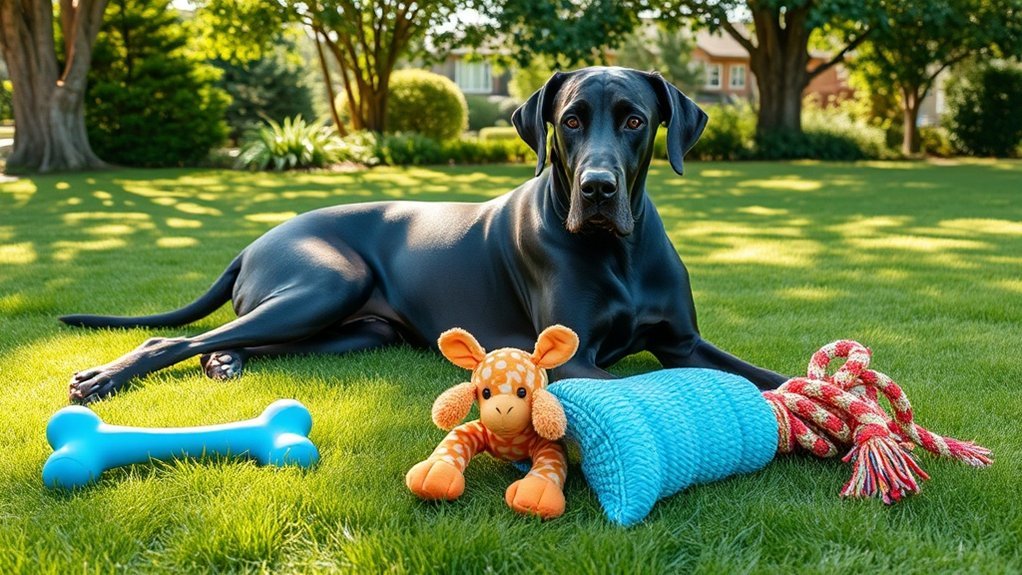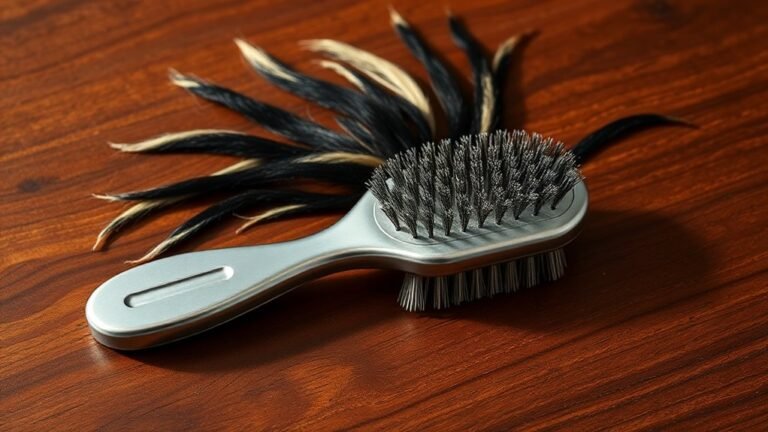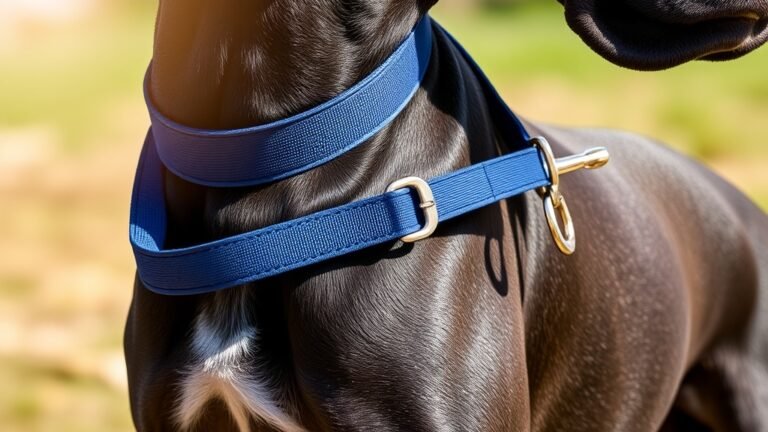Best Great Dane Toys

Best Toys for a Great Dane
Woof! Let me tell you about the toys that make us Great Danes go bonkers with joy!
First things first – we’re not your average lap dog. We’re gentle giants with jaws that could probably open pickle jars (if our humans would let us try). That’s why we need toys tougher than yesterday’s kibble.
The KONG Classic is basically our Holy Grail of toys. You can stuff it with peanut butter, and we’ll spend hours trying to get every last lick. It’s like a delicious puzzle that doesn’t judge us when we drool all over it. Plus, it bounces in crazy directions, which is hilarious when you’re our size and trying to catch it gracefully.
Don’t even get me started on Nylabone DuraChew toys. These bad boys can handle our chompers when we’re feeling extra chewy. We might look dignified, but sometimes we just need to gnaw on something that won’t turn into confetti after five minutes.
Interactive puzzle feeders are genius because they trick us into thinking we’re hunting for food instead of just eating dinner. It’s like a video game, but with treats! We love feeling smart, even though we sometimes walk into glass doors.
Chuckit! Ultra Balls are perfect for fetch because they survive our enthusiastic retrieving. Nothing’s more embarrassing than bringing back half a tennis ball to your human.
The best part? When our humans rotate our toys, it’s like Christmas morning every few days. “Oh wow, Mr. Squeaky! I thought you were gone forever!”
Trust me, keep us entertained with good toys, and we’ll be the happiest gentle giants on the block!
Understanding the Needs of Great Danes
First off, yes, I’m huge. I know this because I can rest my chin on your kitchen counter without even trying. But here’s the thing – just because I’m the size of a miniature horse doesn’t mean I want to run marathons every day. I need my exercise, sure, but I’m more like a couch potato who happens to be tall.
You humans are always trying to figure out my “behavior,” which cracks me up. It’s not that complicated! I want belly rubs, I want to sit on your lap (yes, all 150 pounds of me), and I want to lean against you until you nearly fall over. This is how I show love, okay?
Speaking of toys, please get me the good stuff. Those tiny squeaky toys are insulting. I need toys that won’t disappear in my mouth on the first chomp. And yes, I do need playtime, but remember – I’m basically a giant puppy in a grown-up body.
Get me the good toys! Those tiny squeaky things are a joke. I need big, durable fun for my giant puppy spirit!
Here’s what most people don’t get: I tire out pretty easily. All this bigness is hard work! Too much running and jumping makes my joints feel creaky. I’d rather have a nice walk followed by a three-hour nap on your favorite chair. Plus, having the right mix of toys, like durable chew toys, can help keep me entertained and happy.
The best part of my day? Hanging out with my favorite humans. I don’t need fancy stuff – just time with you, some good food, and a comfy spot to sprawl out.
Trust me, when you understand what makes us Great Danes happy, we’ll be the most loyal, goofy, loveable companions you could ask for.
Key Features of Safe and Durable Toys
When my humans pick out toys for me, they better think about what I can handle with these massive chompers of mine! I’m a Great Dane, which means I’m basically a gentle giant with jaws that could probably crack a walnut (though I prefer my kibble, thanks).
My family has learned the hard way that those cute little squeaky toys made for tiny dogs? Yeah, those last about five seconds in my mouth. It’s like giving a toddler a paper airplane – fun for a hot minute, then it’s destroyed. My humans need to look for toys that say they’re made for “extra large” or “power chewer” dogs. That’s me!
The best toys for us big guys are made from tough rubber or really thick rope. I love when my humans buy me toys that are almost as big as a small human’s head. Not only can I get a good grip on them, but they don’t disappear down my throat like a snack.
Safety is super important too, even though I sometimes act like I could eat a small car. My humans always check that toys don’t have small parts that could break off. Nobody wants a trip to the emergency vet because I decided to snack on a plastic eyeball from my toy!
The funniest part is watching my humans’ faces when I destroy a “super durable” toy in ten minutes. But hey, that’s what happens when you’re 150 pounds of pure playfulness! Early exposure to various environments is also crucial for building confidence and ensuring I don’t develop any fear-based behaviors when interacting with my toys.
Material Safety Standards
Trust me, when you’re as big as I am, you need toys that can handle some serious chomping. My humans are always checking to make sure my toys have those fancy safety certificates. I don’t know what all those big words mean, but apparently, it means the toys won’t make me sick if I accidentally swallow a piece.
And let’s be honest – accidents happen when you’re having a blast!
I love toys made from natural rubber because they’re perfect for my powerful jaws. They bounce great too, which is incredible when I’m trying to catch them mid-air (though I sometimes miss and crash into the coffee table – oops!).
Non-toxic plastic toys are cool too, especially the ones that squeak. My humans seem less thrilled about the squeaking part, but hey, it makes me happy!
The best part about safe toys is that my humans don’t panic every time I play. No more diving across the room to pull dangerous stuff out of my mouth! We all know how that game usually ends – with me thinking it’s a fun chase and them looking stressed out.
It’s also important for my humans to consider rawhide chew risks when selecting toys, ensuring they choose options that are safe and suitable for my size.
Size and Durability
When my humans pick out toys for me, they better make sure they’re BIG enough. Trust me, those tiny squeaky toys meant for Chihuahuas? Yeah, those disappear faster than treats at dinnertime. And by disappear, I mean straight down my enormous gullet! Not exactly what anyone wants.
Size matters when you’re as massive as me. My humans learned this the hard way when they brought home a “medium” rope toy that looked like dental floss in my mouth. Now they know to grab toys made specifically for giant breeds like yours truly.
And let’s talk about durability – because wow, do I know how to destroy things! I don’t mean to, but when you’ve got jaws like mine and the enthusiasm of a puppy, toys don’t stand much of a chance.
The good news is that some companies test their toys to make sure they can handle dogs like me who play hard. My humans always look for toys made with tough, high-quality materials. Early socialization is also vital to help me learn appropriate play behavior with my toys.
The cheap stuff turns into expensive confetti within minutes. When they find the good stuff, though, both of us are happy – I get to play without everything falling apart, and they don’t have to worry about me eating toy pieces or getting bored.
Recommended Toys for Chewing and Playing
Woof! Let me tell you something about toys from a Great Dane who knows what he’s talking about. When you’re as big as me, regular dog toys are basically snacks that disappear in about two seconds flat.
First up, let’s talk about chew toys. I need something that can handle these massive chompers of mine! Those little squeaky toys? Please. I accidentally swallowed one whole once – oops! My humans learned real quick that I need the SUPER heavy-duty stuff.
Think Kong toys made for bears, or antlers bigger than most small dogs. Trust me, your wallet will thank you when you’re not buying new toys every week.
Now, puzzle feeders are where things get interesting. Sure, I might look like all muscle and drool, but I’ve got brains up here too! These contraptions make me work for my food, which is pretty fun. Plus, it slows down my eating so I don’t inhale my dinner in three gulps like usual. My humans seem to think this is “healthier” or whatever. Speaking of health, using positive reinforcement techniques during playtime helps me learn and keeps training engaging!
For fetch, forget those tiny tennis balls – I could lose one between my molars! I need something I can see when it flies through the air. Frisbees work great, especially the rubber ones that don’t crack when I inevitably step on them with my giant paws.
Durable Chew Toys
Let me tell you something important – we Great Danes need SERIOUS chew toys. I’m talking about toys that can handle our massive jaws and endless energy. Trust me, I’ve destroyed my fair share of squeaky toys in about 30 seconds flat!
Finding the right chew toy is like finding the perfect stick in the yard, except it needs to last longer than five minutes. We need toys that won’t turn into a million tiny pieces the moment we get our teeth on them. Plus, our humans are always talking about “dental health” – apparently, chewing helps keep our chompers clean. Who knew? It’s also important for our overall health to maintain a healthy weight by meeting our caloric requirements.
Here are my top three picks that survive the Great Dane test:
- KONG Classic – This red rubber thing is basically indestructible. I’ve been working on the same one for months, and it’s still going strong! You can even stuff it with treats, which makes it a million times better.
- Nylabone DuraChew – These weird bone-shaped toys have bumpy surfaces that feel amazing on my gums. My human says it’s like a toothbrush, but way more fun than those scary dental visits.
- West Paw Zogoflex – This bouncy toy is tougher than it looks. I can throw it around, shake it like crazy, and it still comes back for more. Plus, it’s good for the planet – whatever that means!
These toys keep me busy for hours instead of minutes. And trust me, a bored Great Dane is nobody’s friend – ask my couch!
Interactive Puzzle Feeders
Interactive puzzle feeders are like the ultimate brain workout for us Great Danes! They turn our meal times into fun, engaging activities that get our tails wagging. These clever feeders give us puzzle challenges that make our minds work while slowing down our eating, which is super important when you’re as big as we are!
Instead of gulping down our kibble like a vacuum cleaner (guilty as charged!), we have to think and figure things out. It’s like being a detective, but for dinner! This keeps us from getting bored and doing things like chewing up your favorite shoes – you’re welcome, humans.
The best part? These feeders help our stomachs feel better by making us chew our food properly instead of inhaling it. Trust me, when you’re our size, eating too fast can cause some serious tummy troubles that nobody wants to deal with.
We love all the different types! Some have sliding doors we push around with our giant paws, others have flipping lids that make satisfying little clicks. It’s like a treasure hunt where the treasure is always delicious food. Plus, using puzzle feeders encourages us to engage in structured mental engagement, which helps prevent boredom and destructive behaviors.
Safe Fetch Options
Woof! A Great Dane‘s Guide to Safe Fetch Fun****
Let me tell you, us Great Danes LOVE to play fetch. We get so excited that we sometimes forget our own strength. One minute we’re gently carrying a tennis ball, the next minute… well, let’s just say it looks like it went through a blender! That’s why finding super tough toys is super important for us gentle giants.
Here are my top three favorite fetch toys that can survive playtime with a dog my size:
KONG Extreme – This black rubber toy is basically the superhero of dog toys! I can chomp on it, throw it around, and it still bounces back for more. It’s like the tough guy at the dog park who never backs down from a challenge.
Chuckit! Ultra Ball – This bright orange ball is my best friend! It bounces like crazy (which makes my humans run around like silly geese), and I can always find it in the grass because of that awesome color. Plus, it doesn’t fall apart when I accidentally use my “gentle” 150-pound bite!
Goughnuts Original – Now this toy was made by someone who understands us big chewers. It’s tougher than my morning kibble and has this cool safety feature that shows when it’s time to retire the toy. Smart humans!
The best part about these toys? My humans don’t have to follow me around with a vacuum cleaner picking up toy pieces, and I don’t have to give them those sad puppy dog eyes when I accidentally destroy my favorite ball again. Plus, having a balanced diet is key to keeping my energy up for all this fun!
Remember, us Great Danes might look like we could accidentally step on a small car, but we just want to have safe, fun playtime like every other pup. These toys let us play hard without anyone worrying about us swallowing something we shouldn’t!
Now, if you’ll excuse me, I hear my human getting my KONG ready for some backyard fun. Time to show off my graceful gazelle-like running skills… or at least try not to trip over my giant paws!
Happy fetching, friends!
Engaging Toys for Mental Stimulation
Woof! Let me tell you about the toys that keep my giant brain busy. Sure, I’m a gentle giant with a heart as big as my paws, but I’ve got some serious smarts up here, too!
My humans finally figured out that I need more than just belly rubs to keep me happy. They got me these awesome puzzle toys that make me work for my treats. It’s like being a detective, but instead of solving crimes, I’m solving the mystery of “How do I get this delicious snack out of this weird contraption?”
Those interactive treat dispensers are my absolute favorite! I can spend hours batting them around with my enormous paws, trying to get every last kibble out. My humans think it’s hilarious watching me try to be delicate with something so tiny when I’m basically the size of a small horse.
And don’t even get me started on chew toys with secret hiding spots! It’s like Christmas morning every time I discover there’s something tucked away inside. I feel like a genius when I figure out how to get to the good stuff.
The best part? All this brain work makes me tired in the best way possible. Plus, my humans seem really proud when I solve these puzzles, which means extra cuddles for me. Win-win!
Trust me, keeping that big brain of yours busy is way more fun than staring at the wall all day.
Monitoring and Maintaining Toy Safety
Now that my giant brain is all fired up from playing with my amazing toys, my humans better listen up about toy safety. Trust me, nobody wants a bored Great Dane with broken toys – that’s how your favorite shoes mysteriously disappear!
My humans have learned to check on my toy collection regularly. It’s like being a toy detective, and honestly, I think I’d be pretty good at that job too.
Here’s what they do to keep me happy and safe:
First, they inspect my toys every week. They look for cracks, wobbly parts, or anything that might fall off. I try to help by bringing them my toys, but drooling all over everything doesn’t count as “inspection assistance.” Who knew?
Second, they clean my toys regularly. This prevents yucky bacteria from building up, which is great because the last thing I need is to get sick from my favorite squeaky hamburger. Plus, clean toys taste better when I accidentally lick them during intense play sessions.
Third, they rotate my toys to keep things fresh and prevent me from destroying them too quickly. Smart move, humans!
This way, I don’t get bored, and my poor stuffed animals get a break from my enthusiastic “hugs.” It’s a win-win situation for everyone involved.
Top Brands for Great Dane Toys
When it comes to choosing toys for us Great Danes, you humans can’t underestimate the importance of picking the right brands that work with our massive size and love for playing. Some top brands to check out for toy recommendations include KONG, which makes toys tough enough for our powerful chompers, and Nylabone, famous for toys that last longer than a Netflix series. You can also look into West Paw, which offers eco-friendly choices (because we care about the planet too, even if we accidentally step on flowers sometimes). Here’s a quick comparison of these brands:
| Brand | Key Features |
|---|---|
| KONG | Tough enough for our jaws, interactive fun |
| Nylabone | Super strong, won’t break after one play session |
| West Paw | Earth-friendly, safe stuff we can chew |
Trust me, as a Great Dane who has destroyed more toys than I care to count, these brands hold up to our enthusiasm. Nothing worse than getting excited about a new toy only to have it become confetti in five minutes!
Final Thoughts
Here’s the thing: we need toys that won’t break into a million pieces the second we touch them. Trust me, I’ve destroyed my fair share of “indestructible” toys in about five minutes. Our humans need to find us toys that are tough enough to handle our enthusiasm and big enough that we won’t accidentally swallow them whole.
The right toys don’t just keep us busy – they help us stay happy and healthy. Plus, when our humans pick out awesome toys for us, it shows they really get us. And honestly, there’s nothing better than a good play session to make both of us happy. Just remember: we may be huge, but we’re total softies who just want to have fun!
References
- https://www.pethealthnetwork.com/dog-health/dog-behavior/7-simple-safety-tips-you-buy-your-next-new-dog-toy
- https://spotpet.com/blog/dog-tips/safest-toys-dogs
- https://chuckanddons.com/blogs/news/the-guide-to-dog-toy-safety
- https://www.lordsandlabradors.co.uk/blogs/journal/the-great-dane-ultimate-guide-everything-you-need-to-know
- https://iheartdogs.com/the-20-best-durable-toys-for-great-danes-csc/







One Comment